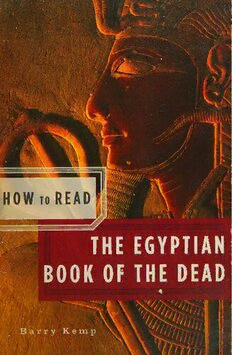
How to Read the Egyptian Book of the Dead PDF
Preview How to Read the Egyptian Book of the Dead
THE EGYPTIAN BOOK OF THE DEAD Barry Kemp Barry Kemp is Professor of Egyptology at the University of Cambridge. His books include Ancient Egypt: Anatomy of a Civilization and 100 Hieroglyphs: Think Like An Egyptian (Granta Books). He is field director of the Egypt Exploration Society’s archaeological work at Tell el-Amarna and chairman of the Amarna Trust (www.amarnatrust.com). HOW TO READ How to Read Beauvoir by Stella Sandford How to Read the Bible by Richard Holloway How to Read Darwin by Mark Ridley How to Read Derrida by Penelope Deutscher How to Read Foucault by Johanna Oksala How to Read Freud by Josh Cohen How to Read Heidegger by Mark Wrathall How to Read Hitler by Neil Gregor How to Read Jung by David Tacey How to Read Kierkegaard by John D. Caputo How to Read Lacan by Slavoj Zizek How to Read Marx by Peter Osborne How to Read Nietzsche by Keith Ansell Pearson How to Read the Qur’an by Mona Siddiqui How to Read Sade by John Phillips How to Read Sartre by Robert Bernasconi How to Read Shakespeare by Nicholas Royle How to Read Wittgenstein by Ray Monk HOW T0 READ THE EGYPTIAN BOOK OF THE DEAD BARRY KEMP First published in Great Britain by Granta Publications Copyright © 2007 by Barry Kemp First American Edition 2008 All rights reserved Printed in the United States of America For information about permission to reproduce selections from this book, write to Permissions, W. W. Norton & Company, Inc. 500 Fifth Avenue, New York, NY 10110 For information about special discounts for bulk purchases, please contact W. W. Norton Special Sales at [email protected] or 800-233-4830 Manufacturing by Courier Westford Production manager: Devon Zahn Extracts used with kind permission: The Book of the Dead, translated by R.D. Faulkner © The Limited Editions Club, New York. Used with kind permission of The Limited Editions Club, New York. Library of Congress Cataloging-in-Publication Data Kemp, Barry J. How to read the Egyptian Book of the dead / Barry Kemp. — 1st American ed. p. cm. — (How to read) Includes bibliographical references and index. ISBN 978-0-393-33079-3 (pbk.) 1. Book of the dead. 2. Incantations, Egyptian. 3. Future life. I. Title PJ1557.K46 2008 299" 3123—dc22 2008019191 W. W. Norton & Company, Inc. 500 Fifth Avenue, New York, N.Y. 10110 Wwww.wwnorton.com W. W. Norton & Company Ltd. Castle House, 75/76 Wells Street, London W1T 3QT 1pSO.R ( SOKO CONTENTS Series Editor’s Foreword Acknowledgements A Note on Translation Introduction Between Two Worlds Working with Myths The Landscape of the Otherworld Voyages and Pathways Reviewing One’s Life The Body’s Integrity Voice and Performance Empowerment Becoming a God Perpetual Fears 100 ss~OSW—o P~R oN oo Notes 108 Chronology 112 Suggestions for Further Reading 114 Index 118 Digitized by the Internet Archive in 2022 with funding from Kahle/Austin Foundation https://archive.org/details/nowtoreadegyptia0000kemp SERIES EDITOR’S FOREWORD How am | to read How to Read? This series is based on a very simple, but novel idea. Most beginners’ guides to great thinkers and writers offer either potted biographies or condensed summaries of their major works, or perhaps even both. How to Read, by contrast, brings the reader face-to-face with the writing itself in the company of an expert guide. Its starting point is that in order to get close to what a writer is all about, you have to get close to the words they actually use and be shown how to read those words. Every book in the series is in a way a masterclass in reading. Each author has selected ten or so short extracts from a writer’s work and looks at them in detail as a way of revealing their central ideas and thereby opening doors on to a whole world of thought. Sometimes these extracts are arranged chronologically to give a sense of a thinker’s development over time, sometimes not. The books are not merely compilations of a thinker’s most famous passages, their ‘greatest hits’, but rather they offer a series of clues or keys that will enable read- ers to go on and make discoveries of their own. In addition to the texts and readings, each book provides a short biographi- cal chronology and suggestions for further reading, Internet viii SERIES EDITOR’S FOREWORD resources, and so on. The books in the How to Read series don’t claim to tell you all you need to know about Freud, Nietzsche and Darwin, or indeed Shakespeare and the Marquis de Sade, but they do offer the best starting point for further exploration. Unlike the available second-hand versions of the minds that have shaped our intellectual, cultural, religious, political and scientific landscape, How to Read offers a refreshing set of first- hand encounters with those minds. Our hope 1s that these books will, by turn, instruct, intrigue, embolden, encourage and delight. Simon Critchley New School for Social Research, New York
